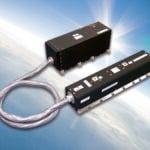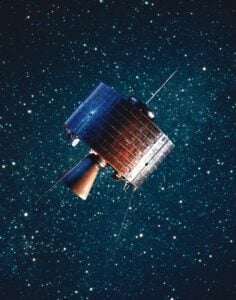Syncom – Geostationary Satellite Communications
Inducted In: 2023, Communications Technology
In 1961, NASA awarded a $4 million contract to the Hughes Aircraft Company to design and build the first geostationary satellites. The three satellites, known as Syncom 1, 2, and 3, were individually launched in 1963 and early 1964, and remained active until 1966. The success of this program proved that geostationary satellites – orbiting at an altitude of 22,000 miles above the Earth – could be used to facilitate Earth-based communication. Together, Syncom 2 and 3 provided communications access to two-thirds of the earth’s surface.
Prior to the Syncom launches, all communication satellites were low-earth orbit (LEO) satellites – orbiting at roughly 1,200 miles. LEO satellites orbit the Earth more than eleven times a day – meaning the satellite is always in motion across the sky relative to an observer on Earth. The ground station required to communicate with the moving satellites required swiveling antennas and expensive tracking computers to maintain contact.
The Syncom satellites – orbiting 22,000 miles above the earth’s equator – were geostationary – meaning they had the same orbital period as the earth’s rotation. The result is that the satellite remains in a fixed position relative to an observer on Earth. This vastly simplified the functionality of the ground station, as it no longer had to track a moving satellite. These advancements transformed communications, television broadcasting, and even weather forecasting.
Syncom 2 was launched in July 1963 and successfully proved the concept. Later that year, President Kennedy used the system to telephone the Nigerian Prime Minister – the first call between heads of state to use satellite relay. Syncom 3, launched the next year, was used to send televised images of the 1964 Tokyo Olympic games back to American viewers watching at home. A new age had begun.
Related Technologies

Beowulf Computing Cluster
Inducted In: Communications Technology, Computer Technology, Featured, Industrial Productivity/Manufacturing Technology
A Beowulf Computing Cluster is a grouping of off-the-shelf computer hardware networked together with fast communication software. The resulting parallel processing power of the collection generates processing speeds faster than most super-computer systems used for complex processing – at a…

Audio Conference Bridge Technology
Inducted In: Communications Technology, Featured
Compunetix was founded in 1968 as a small contract-services technology provider. In 1987, they won a contract to deliver a digital voice switching system for NASA that would accommodate the agency’s wide range of communication needs. At the time, NASA’s…

Traveling-Wave Tube Amplifier
Inducted In: Communications Technology, Computer Technology, Featured
First developed in the 1930s, Traveling-Wave Tube Amplifiers (TWTAs) were designed to amplify radio frequency signals. It was in the early 1960s that NASA and L3 teamed up to evolve the technology so it would meet the transmission needs of…

